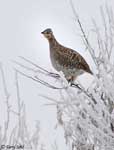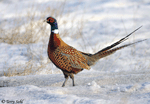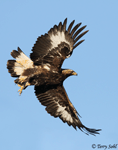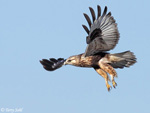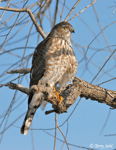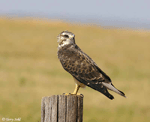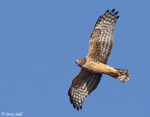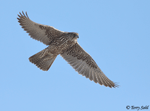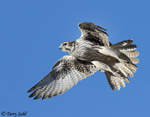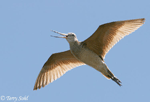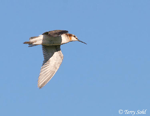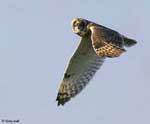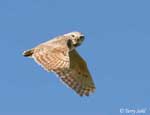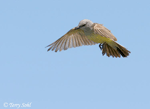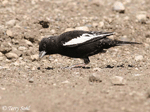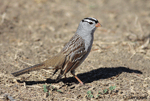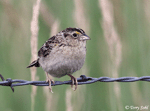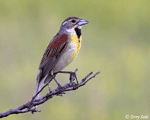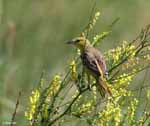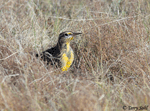South Dakota Birding Hotspot
Fort Pierre National Grasslands
Stanley and Lyman Counties
| Click on points to view actual ground photos and birding information for those locations. Use the Google tools to switch between road maps, terrain, or satellite images. |
Directions:
The Fort Pierre National Grasslands cover almost 200 square miles in the central part of the state. The area is easy to find, as Highway 83 runs north/south through the middle of the Grasslands. The northern boundary is approximately 5 miles south of Pierre, while the southern boundary is approximately 5 miles north of Interstate 90.
Geographic Coordinates: 44° 12' 33" N, 100° 20' 45" W (Intersection of Highway 83 and County Line Road, in the heart of the grasslands).
Description:
The Fort Pierre National Grasslands offer vast expanses of open grassland on gently rolling hills or flatlands. Grassland is interspersed with private holdings, with significant grazing (on Grassland areas as well) and scattered crops (primarily wheat or sorghum). Stock dams are scattered throughout the Grasslands, offering water sources which attract bird life as well as other animals. Access to the Grasslands is good, with gravel roads criss-crossing most of the region. There is no development within the Grasslands, other than scattered farmsteads.
The vast open expanses are broken by only scattered patches of trees, primarily near stock dams. Prairie Dog towns are scattered throughout the Grasslands, and often attract Burrowing Owls and other species which frequent the towns. In most places, the only other features are fencelines and the occasional row of telephone poles. The region can be very good for birding at any time of year. Summer brings the normal grassland species, while winter attracts large numbers (and a variety) of raptors. The open expanses and relatively few natural perches make the region an excellent location to spot (and photograph) raptors.
Points of Note (Click on numbers on the map to see photos of the locations)::
Are you a hardy sort? While the weather can occasionally be brutal, the Fort Pierre National Grasslands in the dead of winter is my favorite location to bird in all of South Dakota. Extremely large numbers of raptors are found here in the winter, including some species rarely found in the lower 48 states. A birder can have success simply by randomly driving the gravel roads which criss-cross the area, but there are certain areas where I've had more luck than others.
The first of these is the famed (in South Dakota birding circles!) "Pheasant Farm", at point 1 on the image to the right. This area can be reached by heading south from Pierre (or north from I-90) along highway 83, until you see "County Line Road" (which is actually 1 mile north of the county line along Highway 83). Head east on County Line Road for 5 1/2 miles, and the road will jog to the south. 1 mile south, the road will turn back towards the east. A small old schoolhouse sits at this corner (check the chimney, which often has a raptor sitting on it!!), and the pheasant farm itself can be seen about 1/2 mile south of here. I started birding in the winter of 2000 and 2001, and the experience that really sparked my love of birding and photography happened in December 2000, at the Pheasant Farm area. A Gyrfalcon was found hanging out in the area, regularly harassing the Ring-necked Pheasants being raised at the farm, as well as the numerous Sharp-tailed Grouse found in the area. Being new at birding and not even knowing the significance of the species, I make the long trek, arriving right at dawn. To my surprise, immediately upon arriving at dawn, a group of birders in the location simply pointed to the Gyrfalcon sitting on a telephone pole near the Pheasant Farm. It wasn't until reading about the species that night at home that I realized what a true rarity the species is in the lower 48. However, Gyrfalcons are often found in this area, as well as a good variety of other raptors in winter as well. A drive east from Highway 83 on County Line Road will always result in a number of raptors being seen on fence posts and telephone poles in the winter.
A second area I always make a point of visiting is the vicinity of the Richland Wildlife Area (point 2). To reach this area, go to the same intersection of Highway 83 and County Line Road, but head west. Follow the road (generally west, with curves) about 3 1/2 miles until the first intersection. Head south, and in about another 3 1/2 miles, you'll see the area on the west side of the road. A small reservoir is found here, with shelterbelts and other trees around the reservoir. Wonderful prairie on rolling hills is found in the area. If you head south past the reservoir, there will be a small gate (often with the barbed wire gate closed) with a very small road heading west through the prairie. This is another great spot to bird, especially for raptors and species that frequent prairie dog towns, as there's a large town west of the main road about a mile. Richland is another area where I've often found Gyrfalcons, and the prairie dog town is a great place to look for migrating grassland rarities like Sprague's Pipit or Long-billed Curlew.
Another similar area to the reservoir at Richland is point 3 on the map to the right is the Sherriff Dam area. Just head south from Richland Wildlife Area, taking the first right, and following the jogs in the road about 3 1/2 miles until the trees and dam of the area are sighted. I've not had quite as much luck here as I have at the nearby Richland Wildlife Area, but have had some memorable sightings. There are a number of cedar and deciduous trees below the dam (on the north side of the little reservoir), an area that has often had some surprises. I've found a Bohemian Waxwing amongst a large flock of Cedar Waxwings, a Townsend's Solitaire, and a Sharp-shinned Hawk in these trees. As with the rest of the Grasslands, you never know what species of raptor might be seen in the area in winter.
I just LOVE birding prairie dog towns on the Fort Pierre National Grasslands, and perhaps the biggest is in and around point 4, just to the east of the actual boundary of the Fort Pierre national Grasslands. Just follow County Line Road east from Highway 83 for about 17 or 18 miles, and you can't help but see the massive prairie dog town on the north side of the road, covering the slope of a very large hill. This has been a wonderful raptor location for me, at all seasons. In summer, Burrowing Owls and Northern Harriers are quite common, while in winter, there always seem to be 2 or 3 Bald Eagles hanging out in some of the few trees in the area (to the south of the town), and Ferruginous Hawks and other raptors are also quite common. Note this is Reservation land, not public land, and I haven't walked the actual prairie dog town, I've just birded from the road.
One last road I normally travel when visiting the area is a gravel road just a mile east of Highway 83, in the northern part of the Grasslands (point 5). If you take County Line Road east of Highway 83, this road is the first north. It can get a little hairy up towards the northern end, especially in winter or after a rain, but I've always had great luck birding along this road. The road bisects a few little stock ponds, and these general areas have been great and held some surprises, such as nesting Marbled Godwits. The east side of this road has some very nice grassland, while the west side seems to have more managed lands with some crops. Maybe it's because the road is less traveled than many in the area, but the fence posts along the road seem to hold about 2 or 3 raptors for every mile you travel in winter. I have photographed a very large variety of raptors along this road, including a Snowy Owl just to the north and east of here.
Birds of Note:
Raptors, Raptors, Raptors!!!!! My GOODNESS, if you want to see an incredible number and variety of raptors, come to the Fort Pierre National Grasslands during the winters months. It can be (and normally IS!) truly astounding in terms of raptor density and variety, and you may find something you'd be hard-pressed to find elsewhere in the lower 48 states. Spend a winter day driving around the Grasslands, and you won't break a sweat to find 75+ individual raptors, often at very close range as they hang out on fencelines and telephone poles near the roads. Summer months can be good for raptors on the Grasslands, with Northern Harriers, Red-tailed Hawks, and Swainson's Hawks often found. But it's the winter months that are truly special.
How special? Normally I'm too busy taking photos and enjoying myself to count, but on the few occasions where I've counted raptors on a winter trip, a typical tally would be 50+ Rough-legged Hawks (these guys are EVERYWHERE in winter), several Northern Harriers, Ferruginous Hawks, and Golden Eagles, scattered Prairie Falcons, Red-tailed Hawks, and Bald Eagles, and the occasional Snowy Owl, Gyrfalcon, or Merlin. I've even found both Sharp-shinned and Cooper's Hawks on the Grasslands.
Do you like Owls? How about the possibility of seeing 8 species of owls in one day? It's possible in the Fort Pierre National Grasslands and Pierre area in early spring. The first spring after I started birding, I had a very memorable April Fool's Day (2001). It was a great year for Snowy Owls, including some hanging around late, and I found a pair hanging out on some of the last remaining patches of snow, along County Line Road. In a prairie dog town further west, I found an early Burrowing Owl (as well as a Long-billed Curlew). Short-eared Owls can be found year-round (although sporadically). Long-eared Owls winter in cedars in and around Pierre and the Oahe Dam area, and breed there as well. Northern Sawwhet Owls commonly winter in these same locations. Eastern Screech Owls can be found in forested areas, and have been found in scattered groves of trees on the Grasslands themselves, as have Great Horned Owls. The Pierre birding crowd has found that Barn Owls commonly nest in burrows along the Missouri River and Oahe reservoir, and sometimes overwinter as well. Will you actually see 8 owl species in one day? I truly doubt it, but it seems like a trip to the area always turns up SOME type of owl, and I have no doubt that on that April 1, 2001, there were indeed 8 owl species hanging out in the area.
This page has obviously focused on the raptors in the Fort Pierre National Grasslands, but the birding opportunities definitely don't stop there. I enjoy birding the area in other seasons almost as much as I do in winter. Upland Sandpipers seem to be hanging out on every fence post at times. Sharp-tailed Grouse and Greater Prairie Chickens can be seen displaying on their leks in the Spring. Marbled Godwits and Wilson's Phalarope can be found breeding on some of the stock dams and reservoirs in the Grasslands, and Long-billed Curlews may occasionally be found (primarily in migration). That gray blob on a fence post may be a resting Common Nighthawk in the summer months. Other species commonly seen along fenclines are both Eastern and Western Kingbirds, Western Meadowlark, Bobolinks, Orchard Orioles, Loggerhead Shrikes (or Northern Shrikes in the winter), Dickcissels, Lark Buntings, and a large number of typical grassland sparrows and other species.
Other Birding Locations (sorted by distance):
- Pierre and Oahe dam Area (~10 miles)
- Presho Area (~30 miles)
- LaCreek National Wildlife Refuge (~140 miles)
- Western Minnehaha County (~170 miles)
- Lake Thompson Area (~180 miles)
- Wall Lake / Dewey Gevik (~180 miles)
- Madison Waterfowl Production Area (~195 miles)
- Outdoor Campus in Sioux Falls (~195 miles)
- Big Sioux Recreation Area (~200 miles)
- Beaver Creek Nature Area (~205 miles)
- Good Earth State Park (~205 miles)
- Newton Hills State Park (~220 miles)
- Gavin's Point Dam (~220 miles)
- Dakota Nature Park, Brookings (~230 miles)
- North Alabama Bend (~240 miles)
